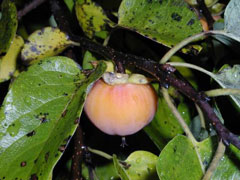


Home
Flowers &
Indoor Plants
Fruits & Nuts
Ornamentals
Vegetables
Special Topics
Resources
Glossary

|
Persimmon Diospyros sp. (di-o-spur-os)    Click on thumbnails for larger image. |
 |
What about it? Both the American, D. virginiana, and Oriental, D. kaki, persimmons are orange fruits with a sweet flavor. The American persimmon is a 35-40 foot tall deciduous tree with dark green, oval-shaped leaves, while the Oriental persimmon is a 25-30 foot tall deciduous tree with heart-shaped leaves. The bark is interesting, as is the exceptional fall color of these trees. Overall, the persimmon is an excellent ornamental and fruit tree! What is it used for?As stated above, the persimmon is enjoyed for its ornamental qualities, and for its orange fruits. Where does it grow? How do we grow it? Both types of persimmon require full sun and tolerate a broad range of oil types, but need good drainage. The American persimmon is more hardy than the Oriental. Persimmons are relatively drought resistant once they are established. Both species grow slowly. Light pruning and training are generally recommended. What are its primary problems? Leaf rollers, lemon tree borers, scale insects, mealy bugs, and fruit rot are all common to the persimmon. Birds are also a serious problem. How do we harvest and store it? Persimmon fruit can be harvested while firm and slightly underripe, but can only be eaten after they become very ripe, and deep orange to red in color. The unripe fruit of persimmon is very astringent, and gives the mouth an awful feeling upon eating it! Allow to ripen indoors at room temperature.
© Copyright, Department of Horticulture, Cornell University. |